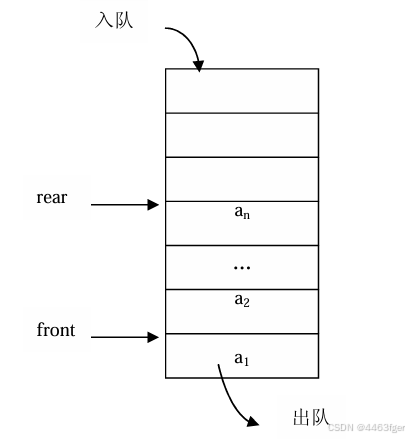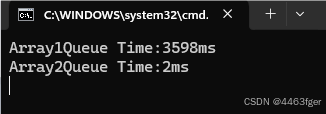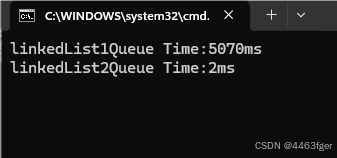说明
(此系列帖子记录数据结构学习成果,如侵犯视频作者权益,立删)
视频链接:离忧夏天C#数据结构
本文实现队列需要用到动态数组ArrayList和单链表的相关知识,详细请看:C#数据结构专栏
文章目录
一:队列的基本概念
队列是一种遵循先进先出原则的线性表
二:队列的基本操作
- 入队(Enqueue)
- 出队(DeQueue)
- 获取队列的大小(Count)
- 检查队列是否为空(IsEmpty)
- 查看队头元素(GetFirst)
实现队列的接口
interface IQueue<T>
{
//查看元素数量
int Count { get; }
//判空
bool IsEmpty { get; }
//入队
void Enqueue(T t);
//出队,并返回元素
T Dequeue();
//查看队首的元素
T Peek();
}
三:队列的实现
1.数组队列(由动态数组实现)
| 数组队列 | 时间复杂度 |
|---|---|
| 入队(Enqueue) | O(1) |
| 出队(DeQueue) | O(n) |
| 获取队列的大小(Count) | O(1) |
| 检查队列是否为空(IsEmpty) | O(1) |
| 查看队头元素(GetFirst) | O(1) |
class Array1Queue<T> : IQueue<T>
{
private Array1<T> arr;
public int Count => arr.Count;
public bool IsEmpty => arr.IsEmpty;
//传入容量
public Array1Queue(int capacity)
{
arr = new Array1<T>(capacity);
}
//无参
public Array1Queue()
{
arr = new Array1<T>();
}
//入队
public void Enqueue(T t)
{
//选择数组尾部作为队尾
arr.AddLast(t);
}
//出队
public T Dequeue()
{
return arr.RemoveFirst();
}
//查看队首的元素
public T Peek()
{
return arr.GetFirst();
}
public override string ToString()
{
return "Queue: Head" + arr.ToString() + "Tail";
}
}
2.循环队列(由循环数组实现)
循环数组其中的元素可以在数组的末端重新改回到起始位置,其头尾相连形成一个闭环。
- 头部由fist指针标识
- 尾部由last指针标识
- 当到达数组的末尾时,last指针会重写指向数组的起始位置,从而充分利用整个数组空间,避免了不必要的内存浪费。
- 其中需要取余操作是必须的,这样可以保证数组的循环,即(last+1)% data.length
循环数组的实现
class Array2<T>
{
private T[] data; //静态数组存储元素
private int first; //记录头部
private int last; //记录尾部
private int N; //当前元素个数
public Array2(int capacity)
{
data = new T[capacity];
first = 0;
last = 0;
N = 0;
}
public Array2() : this(10) { }
public int Count => N;
public bool IsEmpty => N == 0;
//添加元素
public void AddLast(T t)
{
if(N ==data.Length)
ResetCapacity(2*data.Length);
data[last] = t;
last = (last+1)%data.Length;
N++;
}
//删除元素
public T RemoveFirst()
{
if (IsEmpty)
throw new InvalidOperationException("数组为空");
T ret = data[first];
data[first] = default(T);
first = (first + 1) % data.Length;
N--;
if(N == data.Length/4)
ResetCapacity(data.Length/2);
return ret;
}
//获取头部元素
public T GetFirst()
{
if (IsEmpty)
throw new InvalidOperationException("数组为空");
return data[first];
}
//扩容
private void ResetCapacity(int newCapacity)
{
//临时数组用于转移元素
T[] newData = new T[newCapacity];
for (int i = 0; i < N; i++)
newData[i] = data[(first+i)%data.Length];
data = newData;
first = 0;
last = N;
}
public override string ToString()
{
StringBuilder res = new StringBuilder();
res.Append("[");
for (int i = 0; i < N; i++)
{
res.Append(data[(first + i) % data.Length]);
if ((first + i + 1) % data.Length != last)
res.Append(",");
}
res.Append("]");
return res.ToString();
}
}
循环队列的实现
| 循环队列 | 时间复杂度 |
|---|---|
| 入队(Enqueue) | O(1) |
| 出队(DeQueue) | O(1) |
| 获取队列的大小(Count) | O(1) |
| 检查队列是否为空(IsEmpty) | O(1) |
| 查看队头元素(GetFirst) | O(1) |
//循环队列
class Array2Queue<T> :IQueue<T>
{
//循环数组作为底层的数据结构
private Array2<T> arr;
//创建容量为capacity的队列
public Array2Queue(int capacity)
{
arr =new Array2<T>(capacity);
}
//使用默认的容量创建队列
public Array2Queue()
{
arr = new Array2<T>();
}
//获取队列元素的个数O(1)
public int Count => arr.Count;
//查看队列是否为空O(1)
public bool IsEmpty => arr.IsEmpty;
//入队,往队尾添加元素O(1)
public void Enqueue(T t)
{
arr.AddLast(t);
}
//出队,删除队首的元素O(1)
public T Dequeue()
{
return arr.RemoveFirst();
}
//查看队首的元素O(1)
public T Peek()
{
return arr.GetFirst();
}
//打印循环队列信息
public override string ToString()
{
return "Queue: front" + arr.ToString() + "tail";
}
}
3.链表队列(由只带头指针的链表实现)
因为在向单链表添加元素的过程中,每次添加元素,我们都需要用一层for循环遍历到链表尾部,然后再添加元素,因此入队的时间复杂度是O(n)
| 链表队列 | 时间复杂度 |
|---|---|
| 入队(Enqueue) | O(n) |
| 出队(DeQueue) | O(1) |
| 获取队列的大小(Count) | O(1) |
| 检查队列是否为空(IsEmpty) | O(1) |
| 查看队头元素(GetFirst) | O(1) |
class LinkedList1Queue<T>:IQueue<T>
{
//链表
private LinkedList01<T> list;
private LinkedList1Queue()
{
list = new LinkedList01<T>();
}
public int Count => list.Count;
public bool IsEmpty => list.IsEmpty;
//删除队列头部==删除链表头部O(1)
public T Dequeue()
{
return list.RemoveFirst();
}
//添加到队列尾部==添加链表尾部O(n)
public void Enqueue(T t)
{
list.AddLast(t);
}
//查看队列头部==查看链表头部O(1)
public T Peek()
{
return list.GetFirst();
}
public override string ToString()
{
return "Queue front" + list.ToString() +"tail";
}
}
4.链表队列(由带头尾指针的链表实现)
和只有头指针的单链表类似,在尾指针添加元素,只需要让尾指针的下一个节点为newNode,并让newNode为尾指针即可
即tail.next = node; tail = node;
| 链表队列(带尾指针) | 时间复杂度 |
|---|---|
| 入队(Enqueue) | O(1) |
| 出队(DeQueue) | O(1) |
| 获取队列的大小(Count) | O(1) |
| 检查队列是否为空(IsEmpty) | O(1) |
| 查看队头元素(GetFirst) | O(1) |
带尾指针的单链表的实现
//带有尾指针的单链表
class LinkedList02<T>
{
//链表的节点类
private class Node
{
public T data;
public Node next;
public Node(T data, Node next)
{
this.data = data;
this.next = next;
}
public Node(T data)
{
this.data = data;
this.next = null;
}
public override string ToString()
{
return base.ToString();
}
}
private Node head;
private Node tail;
private int N;
public LinkedList02()
{
head = null;
tail = null;
N = 0;
}
public int Count => N;
public bool IsEmpty => N == 0;
//往链表尾部添加元素
public void AddLast(T t)
{
Node node = new Node(t);
if(IsEmpty)
{
head = node;
tail = node;
}
else
{
tail.next = node;
tail = node;
}
N++;
}
//链表头部删除节点
public T RemoveFirst()
{
if (IsEmpty)
throw new InvalidOperationException("链表为空");
//删除的元素
T t = head.data;
//移动指针
head = head.next;
N--;
if (head == null)
{
tail = null;
}
return t;
}
//查看头部
public T GetFirst()
{
if (IsEmpty)
throw new InvalidOperationException("链表为空");
return head.data;
}
public override string ToString()
{
StringBuilder sb = new StringBuilder();
Node cur = head;
while (cur != null)
{
sb.Append(cur.data + "->");
cur = cur.next;
}
sb.Append("Null");
return sb.ToString();
}
}
通过带有尾指针的链表实现的队列
//带尾指针的链表队列
class LinkedList2Queue<T>:IQueue<T>
{
//基于带尾指针的链表实现
private LinkedList02<T> list;
public LinkedList2Queue()
{
list = new LinkedList02<T>();
}
public int Count => list.Count;
public bool IsEmpty => list.IsEmpty;
//入队
public void Enqueue(T t)
{
list.AddLast(t);
}
//出队,并返回元素
public T Dequeue()
{
return list.RemoveFirst();
}
//查看队首的元素
public T Peek()
{
return list.GetFirst();
}
public override string ToString()
{
return "Queue front" + list.ToString() +"tail";
}
}
四:性能分析比较
对于队列的测试,编写TestQueue方法
//测试队列的性能
private static long TestQueue(IQueue<int> queue, int N)
{
Stopwatch t = new Stopwatch();
t.Start();
for (int i = 0; i < N; i++)
{
queue.Enqueue(i);
}
for (int i = 0; i < N; i++)
{
queue.Dequeue();
}
t.Stop();
return t.ElapsedMilliseconds;
}
数组队列 VS 循环队列
static void Main(string[] args)
{
int N = 100000;
//数组队列
Array1Queue<int> array1Queue = new Array1Queue<int>();
long t1 = TestQueue(array1Queue, N);
Console.WriteLine("Array1Queue Time:" + t1+"ms");
//循环队列
Array2Queue<int> array2Queue = new Array2Queue<int>();
long t2 = TestQueue(array2Queue, N);
Console.WriteLine("Array2Queue Time:" + t2 + "ms");
Console.ReadKey();
}
我们可以清楚的看到,循环队列的性能对于数组队列是大幅度提升的。
由只有头指针链表实现的队列 VS 由具有头尾指针链表实现的队列
static void Main(string[] args)
{
int N = 100000;
//链表队列(头指针)
LinkedList1Queue<int> linkedList1Queue = new LinkedList1Queue<int>();
long t1 = TestQueue(linkedList1Queue, N);
Console.WriteLine("linkedList1Queue Time:" + t1+"ms");
//链表队列(头尾指针)
LinkedList2Queue<int> linkedList2Queue = new LinkedList2Queue<int>();
long t2 = TestQueue(linkedList2Queue, N);
Console.WriteLine("linkedList2Queue Time:" + t2 + "ms");
Console.ReadKey();
}
我们可以清楚的看到,通过优化链表,使得具有尾指针,并通过尾指针添加元素,使得性能对于普通的单链表是大幅度提升的。


